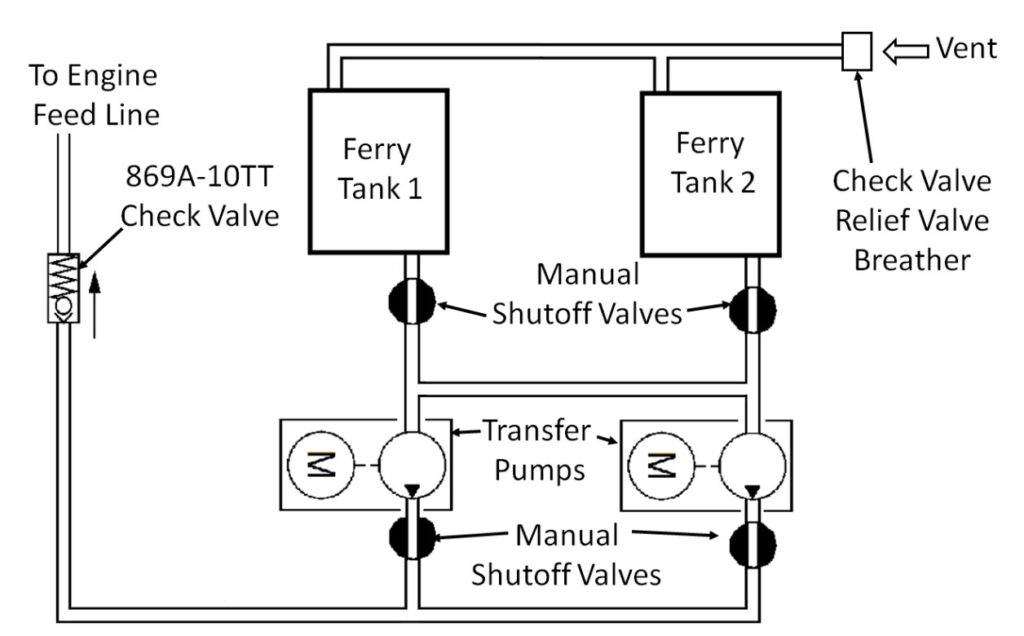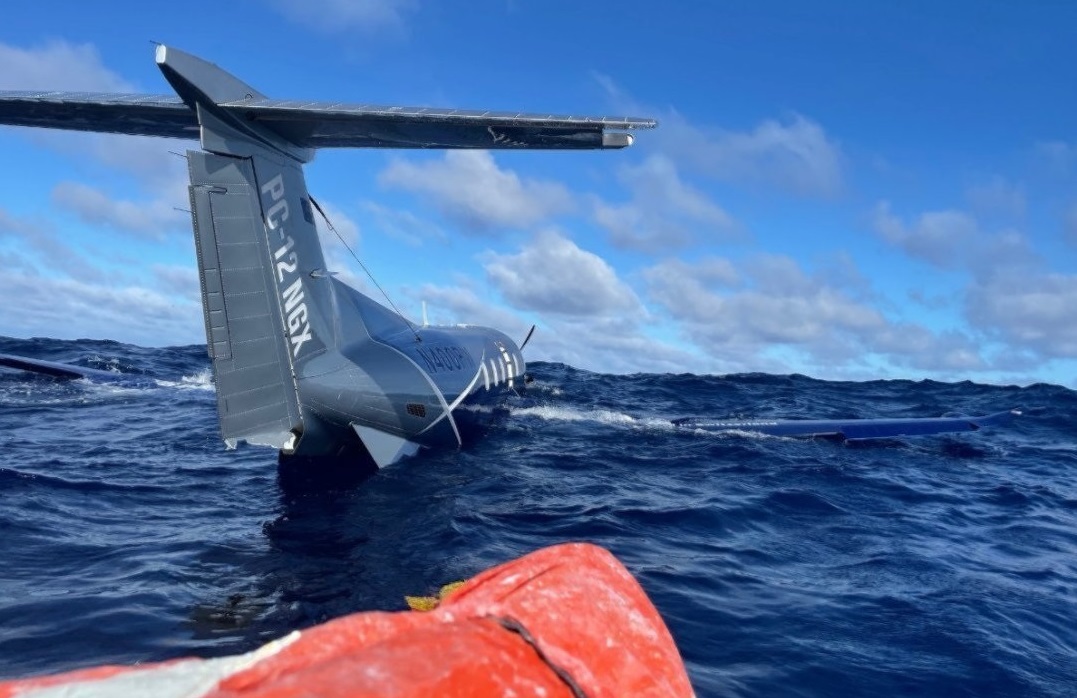Pilatus PC-12 Pacific Ditching (N400PW Ferry Flight)
On 6 November 2020 Pilatus PC-12NGX N400PW ditched in the Pacific Ocean about 870 nm east of Hilo, Hawaii during a ferry flight. The two crew were rescued uninjured after 22 hours.
The US National Transportation Safety Board (NTSB) explain in their preliminary report that…
…the pilot-in-command (PIC), who was also the ferry company owner….and another pilot were ferrying a new airplane from California to Australia. The first transoceanic
leg was planned for 10 hours from Santa Maria Airport (KSMX), California to Hilo Airport (PHTO), Hawaii.The manufacturer had an auxiliary ferry fuel line and check valve installed in the left wing before delivery. About 1 month before the trip, the pilot hired a ferry company to install an internal temporary ferry fuel system… The crew attempted the first transoceanic flight on November 2, but the ferry fuel system did not transfer properly, so the crew diverted to Merced Airport (KMCE), California.
The system was modified with the addition of two 30 psi fuel transfer pumps that could overcome the ferry system check valve. The final system consisted of 2 aluminum tanks, 2 transfer pumps, transfer and tank valves, and associated fuel lines and fittings. The ferry fuel supply line was connected to the factory installed ferry fuel line fitting at the left wing bulkhead, which then fed directly to the main fuel line through a check valve and directly to the turbine engine. The installed system was ground and flight checked before the trip.
The aircraft departed Santa Maria about 1000.
The pilots each stated that the ferry fuel system worked as designed during the flight and they utilized the operating procedures that were supplied by the installer.
About 5 hours after takeoff, approaching ETNIC intersection, the PIC climbed the airplane to flight level 280. At that time, the rear ferry fuel tank was almost empty, and the forward tank was about 1/2 full. The crew was concerned about introducing air into the engine as they emptied the rear ferry tank, so the PIC placed the ignition switch to ON.
According to the copilot (CP), she went to the cabin to monitor the transparent fuel line from the transfer pumps to ensure positive fuel flow while she transferred the last of the available rear tank fuel to the main fuel line. When she determined that all of the usable fuel was transferred, and fuel still remained in the pressurized fuel line, she turned the transfer pumps to off and before she could access the transfer and tank valves, the engine surged and flamed out.
The PIC stated that the crew alerting system (CAS) fuel low pressure light illuminated about 5 to 15 seconds after the transfer pumps were turned off, and then the engine lost power and the propeller auto feathered. The PIC immediately placed the fuel boost pumps from AUTO to ON. The CP went back to her crew seat and they commenced the pilot operating handbook’s emergency checklist procedures for emergency descent and then loss of engine power in flight.
The crew attempted an engine air start.
The propeller unfeathered and the engine started; however, it did not reach flight idle and movement of the power control lever did not affect the engine. The crew secured the engine and attempted another air start. The engine did not restart and grinding sounds and a loud bang were heard. The propeller never unfeathered and multiple CAS warning lights illuminated, including the EPECS FAIL light (Engine and Propeller Electronic Control System). The crew performed the procedures for a restart with EPECS FAIL light and multiple other starts that were unsuccessful.
About 8,000 ft mean sea level, the crew committed to ditching in the ocean.
About 1600, after preparing the survival gear, donning life vests, and making mayday calls on VHF 121.5, the PIC performed a full flaps gear up landing at an angle to the sea swells and into
the wind. He estimated that the swells were 5 to 10 ft high with crests 20 feet apart. During the landing, the pilot held back elevator pressure for as long as possible and the airplane landed
upright.
The aircraft remained afloat initially.
The crew evacuated through the right over wing exit and boarded the 6 man covered life raft.
The crew utilized a satellite phone to communicate with [the FAA] Oakland [Air Traffic] Center. The USCG coordinated a rescue mission.
About 4 hours later, a C-130 arrived on scene and coordinated with a nearby oil tanker, the M/V Ariel, for rescue of the crew. According to the pilots, during the night, many rescue attempts were made by the M/V Ariel; however, the ship was too fast for them to grab lines and the seas were too rough. After a night of high seas, the M/V Ariel attempted rescue again; however, they were unsuccessful.
That afternoon, a container ship in the area, the M/V Horizon Reliance, successfully maneuvered slowly to the raft, then the ship’s crew shot rope cannons that propelled lines to the raft, and they were able to assist the survivors onboard. The pilots had been in the raft for about 22 hours.
The aircraft is presumed to have sunk.
UPDATE 29 Sept 2023: NTSB Issue Final Report
The NTSB safety investigation report and a public docket analysis report reveal that:
A subsidiary of the aircraft manufacturer installed an auxiliary ferry fuel line and check valve in the left wing as a major alteration (per FAA Form 337) that stated, “The ferry tank provisions feed directly into the engine’s fuel supply line.” It also stated that “ferry tank installations should ensure that no air is introduced into the fuel system.”
Another company installed the ferry fuel system that initially consisted of two aluminum tanks, transfer and tank valves, and associated fuel lines and fittings. The company submitted a FAA Form 337 that stated, “The ferry fuel feed is directly to the left main tank.” The ferry fuel supply line was connected to the newly installed ferry fuel line fitting at the left-wing bulkhead, which then fed directly to the main fuel line through a check valve and directly to the engine fuel system.
After an initial ferry flight attempt was abandoned due to a fuel transfer failure:
The system was further modified with the addition of two 30 pounds-per square-inch (psi) fuel pumps that could overcome aircraft’s ejector fuel pump pressure (10 psi) and the ferry system’s check valve.

Pilatus PC-12 N400PW Ferry Fuel System (Credit: NTSB)
However, this significantly modified the aircraft’s fuel system performance during fuel transfer from the ferry fuel tanks. The higher pressure of the ferry system’s transfer pumps, compared to the delivery ejector pumps, resulted in the closure of flap valves in the delivery ejector pumps. Additionally, unused fuel returning to the wing tanks through the motive flow line exacerbated the issue due to closed flap valves.
The aircraft was certified without an air separator in the engine fuel feed line. In addition, the production fuel system design of the accident airplane was such that a Fuel System Icing Inhibitor (FSII) was not required.
Although not required, neither the aircraft manufacturer nor the company that installed the ferry fuel system evaluated 1) the ferry system’s impact on the production fuel system operating temperature; 2) if an FSII should be required; and 3) if not having an air separator in the engine fuel feed line would impact the system.
It is conceivable that the introduction of air into the fuel line from the ferry system played a role, even though the boost pumps should have ideally compressed and expelled any air. Alternatively, ice build-up in the aircraft’s fuel tanks during fuel transfer operations, aggravated when the ferry system was deactivated, might have restricted fuel flow due to viscous fuel or stuck ejector flap valves.
The aircraft commander’s and co-pilot’s statements detail the survival and rescue aspects well.
NTSB Probable Cause
A total loss of engine power due to fuel starvation for reasons that could not be determined based on the available evidence.
The loss of the aircraft at sea prevented a more definitive determination.
2001 Ditching of PC-12 N660AR
On 8 July 2001 PC-12 N660NR ditched off Russia in the Sea of Okhotsk. According to the NTSB:
The pilot reported…that the aircraft was established in cruise at 8,100 meters altitude when he felt a vibration followed by a rapid increase in the engine’s Turbine Temperature Indication (TTI). He reported that the TTI reached 1144 degrees during which there was a compressor stall. He shut the engine down, feathered the propeller, and initiated a power off emergency descent.
During the emergency descent the pilot radioed a mayday on 121.5 MHz, set his transponder to code 7700, and manually activated the emergency locator beacon. The aircraft descended through multiple cloud layers during which the pilot and passengers prepared for the ditching.
The pilot reported that upon breaking through the bottom of the last overcast layer, at 100 feet above the water, he encountered swells of approximately 8-12 feet height. He ditched the aircraft on the crest of a swell and the aircraft came to a stop floating in an upright, level attitude. All four occupants exited the aircraft through the main cabin door into a life raft. Over a period of several hours the occupants lost sight of the floating aircraft and after about 15 hours they were picked up by a Russian container ship and airlifted to Sakhalin Island.
The pilot in that case, Michael Smith, reported that he…
…and his passengers had immersion suits to help retain body heat, but their low-cost life raft had only a single flotation tube on the sides, so waves kept coming over the top. They had to keep bailing it out for about 15 hours with a collapsible bucket. “When night fell, [we experienced] hypothermia within a few hours,” he recalled.
A passing vessel discovered Smith and his companions in time to save them. “We were very, very lucky,” he said. “If I’d been trained, I would have had a better life raft and more equipment, such as a satellite phone and GPS.”
Safety Resources
For ferry flight background see: Crossing the Pacific. You may also find these Aerossurance articles of interest:
- NTSB Report on C208B Caravan Ditching, Molokai, Hawaii, 2013
- NH90 Caribbean Loss of Control – Inflight, Water Impact and Survivability Issues
- Production Defect IFSD Triggers Night Deadstick PC-12 Landing
- Confusion of Compelling, But Erroneous, PC-12 Synthetic Vision Display
- UPDATE 9 January 2021: Korean Kamov Ka-32T Fire-Fighting Water Impact and Underwater Egress Fatal Accident
- UPDATE 26 June 2021: Pilatus PC-12 Collided with Pick-Up Truck During Dusk Take Off


Recent Comments